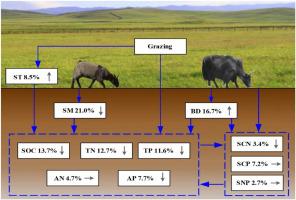Soil and Tillage Research ( IF 6.5 ) Pub Date : 2020-11-04 , DOI: 10.1016/j.still.2020.104822 Chenli Liu , Wenlong Li , Jing Xu , Wei Wei , Pengfei Xue , Hepiao Yan

|
Soil nutrients and stoichiometry are two important fertility indicators for grassland ecosystems, and are essential to maintain ecosystem function and protect land from degradation. Although many case studies have been conducted, the effect of grazing management on soil nutrients of alpine grassland is still poorly understood because of the complex nature of grassland soil. In this study, we synthesized the results of 53 peer-reviewed publications and conducted a meta-analysis to explore the effects of grazing on soil nutrient levels. Our results indicated that grazing significantly decreased soil organic carbon (SOC, -13.7 %), soil total nitrogen (TN, -12.7 %), soil total phosphorus (TP, -11.6 %), soil available phosphorus (-7.7 %), soil moisture (SM, -21.1 %) and soil C:N ratio (-3.4 %). In contrast, grazing significantly increased soil bulk density (+16.7 %) and soil temperature (+8.5 %), while it had no effect on soil available nitrogen, or the ratios of C:P and N:P in soil. Specifically, grazing effects on SOC, TN and TP decrease with increasing grazing intensity, but light grazing had no significant effect on them. The response ratio of SOC was significantly positively correlated with the response ratio of TN, SM, C:N and C:P ratios (p < 0.01), suggesting that the mutual influence of soil nutrient variables in alpine grassland under grazing. In addition, the response of soil nutrients to grazing was also affected by grazing season, livestock type and grazing duration. Our study provides new insights into how soil nutrient levels are impacted by different grazing management strategies in alpine grassland ecosystems on the QTP. This information can be form the basis for future studies into sustainable management of alpine grassland.
中文翻译:

青藏高原高寒草地土壤养分和化学计量对放牧管理的响应
土壤养分和化学计量是草原生态系统的两个重要肥力指标,对于维持生态系统功能和保护土地免受退化至关重要。尽管已经进行了许多案例研究,但是由于草地土壤的复杂性,对高寒草地放牧管理对土壤养分的影响仍然知之甚少。在这项研究中,我们综合了53篇经同行评审的出版物的结果,并进行了荟萃分析,以探讨放牧对土壤养分水平的影响。我们的结果表明,放牧显着降低了土壤有机碳(SOC,-13.7%),土壤总氮(TN,-12.7%),土壤总磷(TP,-11.6%),土壤有效磷(-7.7%),土壤水分(SM,-21.1%)和土壤碳氮比(-3.4%)。相反,放牧显着增加了土壤容重(+16.7%)和土壤温度(+8.5%),但对土壤有效氮或土壤中C:P和N:P的比例没有影响。具体而言,放牧对SOC,TN和TP的影响随放牧强度的增加而降低,但轻度放牧对其无明显影响。SOC的响应率与TN,SM,C:N和C:P的响应率显着正相关(p <0.01),表明放牧条件下高寒草地土壤养分变量的相互影响。此外,土壤养分对放牧的响应也受放牧季节,牲畜类型和放牧持续时间的影响。我们的研究为QTP的高山草原生态系统中不同的放牧管理策略如何影响土壤养分水平提供了新的见解。这些信息可以作为将来对高寒草地可持续管理进行研究的基础。


























 京公网安备 11010802027423号
京公网安备 11010802027423号